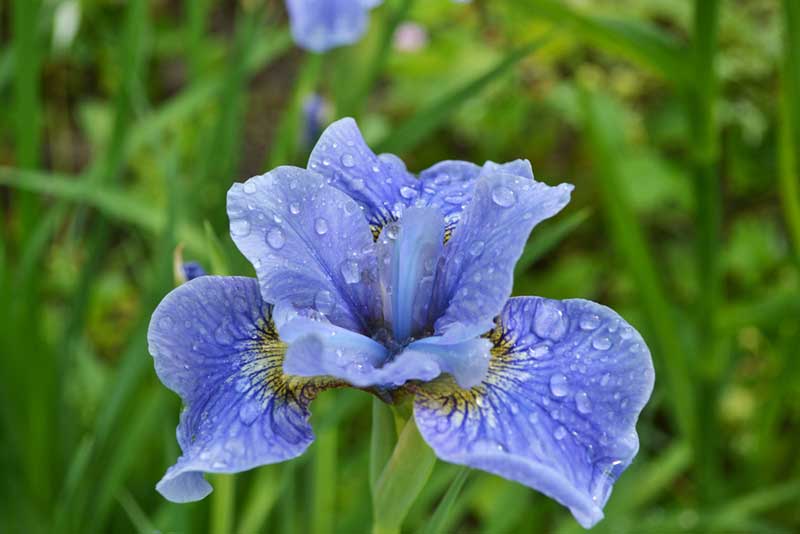
The iris is an iconic flower that has about 300 varieties. It grows in zones 3 through 9 and comes in virtually every color, even black. You can get multi-color irises as well as single-color irises. They bloom in the springtime through the summer, depending on the specific variety, and some types bloom twice. They can grow to be anywhere from 12″ to 40″ tall, depending on the variety.
Irises come in crested “beardless” types and bearded types. A bearded iris has hairs that grow on the out petals that hang. In the crested type, these hairs are in the shape of a comb.
Light and Temperature Requirements
In general, irises need full sunlight in order to grow and bloom at their best. They can still thrive in places that have at least six to eight hours of direct sun each day. They will grow in the shade, though they are not likely to bloom there. Irises planted in the shade also suffer from more diseases. If your climate is extremely hot, they can actually benefit from having a little shade in the afternoons. They are hardy as far as temperature requirements. When there are temperature extremes, irises don’t mind.
Watering
When iris plants are becoming established, they need regular watering to keep their roots moist. Once the plants have become established, they need to be watered only when the top couple of inches of soil are dry. Be sure not to water it too often, and water it deep enough each time to penetrate the roots. If it rains regularly, this may be enough water for your irises. They are reasonably drought tolerant, but they do better when they get water regularly. Make sure the area that you plant them in has good drainage to keep the roots from sitting in too much water.

Soil and Fertilizing
The soil that you choose has to have excellent drainage, making soils of heavy clay not work well for irises. Soils that are gravelly or sandy work well. You can still plant them in heavy soils as long as you prepare the soil or used raised flower beds with lighter soil inside. You can lighten their soil with compost or other organic matter to make the soil richer. Adding gypsum is another way to lighten the soil.
It’s best to have soil that is slightly acidic with about a 6.8 pH, though they tend to be tolerant of soils that aren’t perfect for them. If your soil is too acidic, you can add lime to it to make it better for your irises. If the soil is too alkaline, you can add sulfur. It is a good idea to test your soil before you try to correct its pH.
If you want to fertilize your irises, a low-nitrogen fertilizer, such as a 6-10-10, can be used. They should not have too much nitrogen added to the soil, as this will make the plant bloom less. A good fertilizer for irises is bone meal, and alfalfa without salt is also helpful. Fertilize lightly in the spring and then a month later.
Deadheading and Pruning
Irises are often pruned in the fall to keep the plants neat and tidy as well as to keep the foliage from attracting pests like caterpillars and fungal diseases. If you remove foliage from the plant, do not put it in with your compost. Pruning in the fall can be done by cutting away all of the foliage back to just a few inches above the soil.
Deadheading is usually done for aesthetic reasons and can be done by cutting away any flower stalks that are spent after the bloom time, but the foliage should be left in place until the fall pruning.
About every three years, you can divide the underground rhizomes to keep the irises from spreading too far. They can become invasive if they are left to spread unchecked. They will also bloom better if the rhizomes are thinned out.

Propagation
Dividing the rhizomes is one way to propagate irises. In August, dig them up and cut the rhizomes apart so that each one has a foliage fan.
You can also remove entire clumps of rhizomes in order to spread your plants elsewhere. Replant the rhizomes that you remove in an area with good drainage and full sunlight all or most of the day.
Rhizomes are best planted from July through September. It should be about four to six weeks before the season’s first hard freeze. The temperature at night should be anywhere from 40 to 50 degrees when you plant them.







